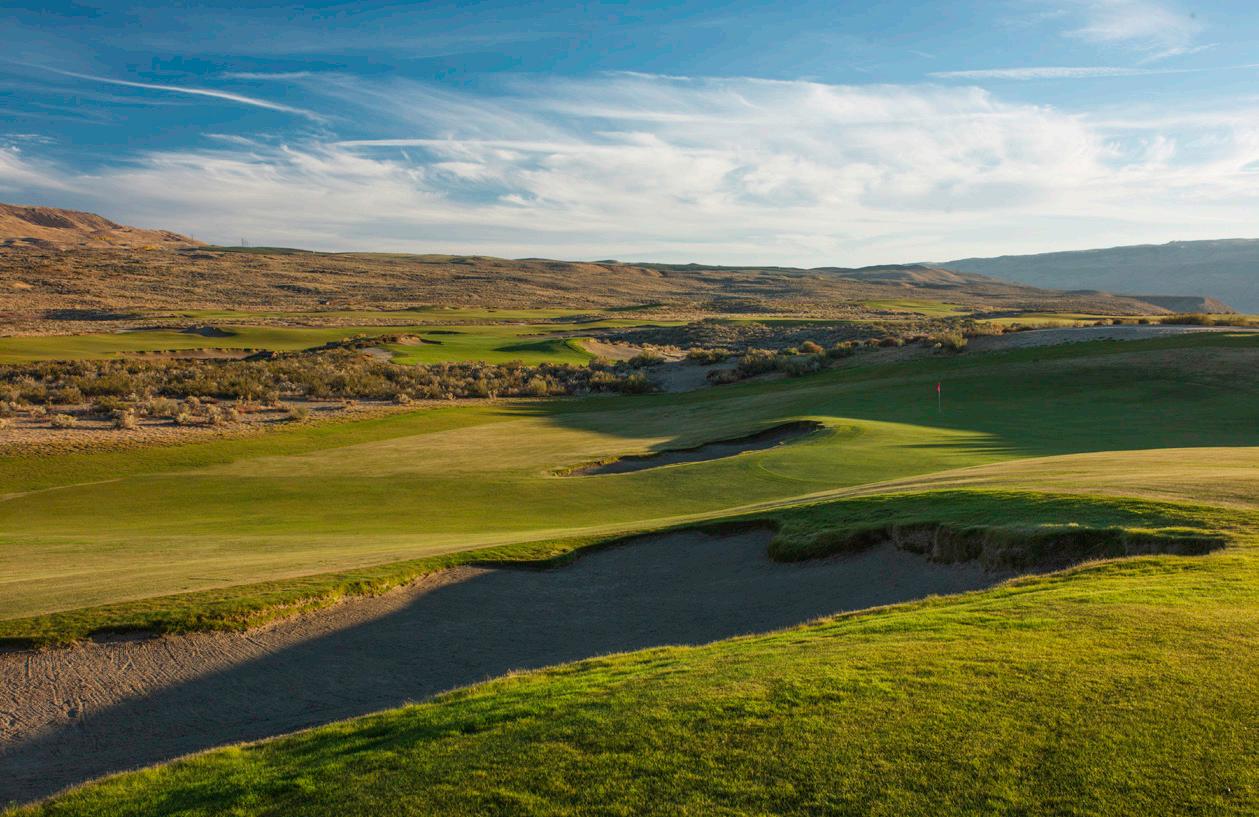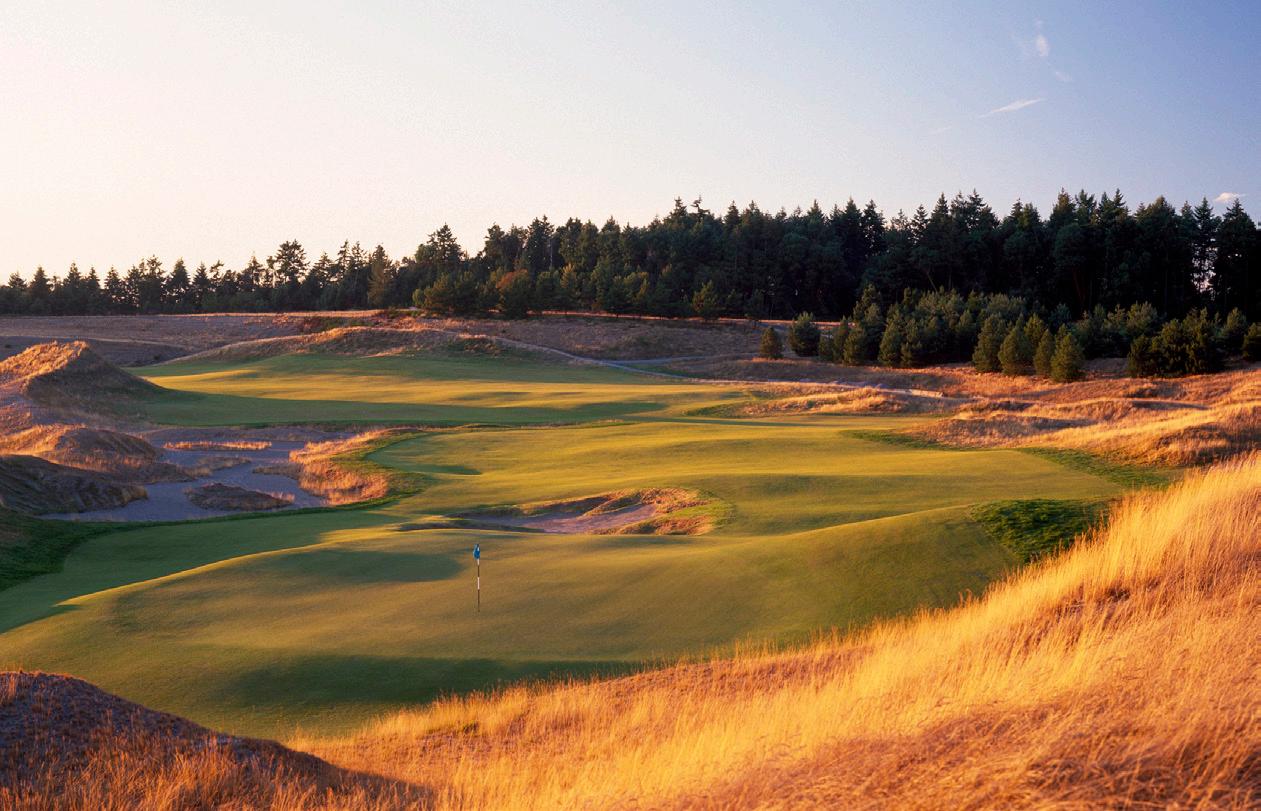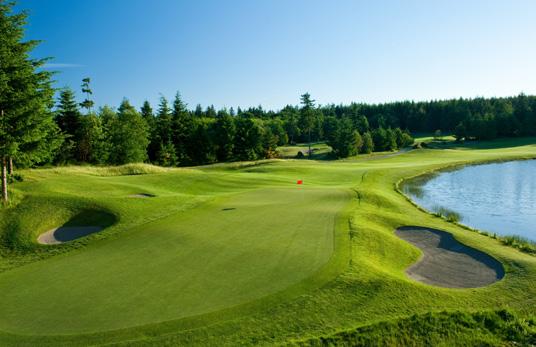
9 minute read
After three months of layoffs and lost revenue, our local golf courses are back in business — and demand has never been greater

Chambers Bay, No. 13
BY JOSH KERNS
TALK ABOUT AN EXPLOSION.
When Washington Governor Jay Inslee gave the go-ahead for golf to resume following his nearly six-week COVID-19 stay-at-home order, it was like someone had shaken a bottle of champagne and popped the cork.
Golfers across the state inundated courses, and from local munis to the big dogs in the business, tee sheets have been booked solid from dawn to dark. And, it couldn’t have come any quicker for players and industry professionals alike.
“That six-week shutdown was terrifying. We didn’t know what to expect,“ says Scott Barter, General Manager of the family-owned Mount Si Golf Course in Snoqualmie. “It was getting scary and things were getting tight. But, since May fifth (when golf courses could again operate with stringent safety measures in place), we’ve been as busy as I’ve ever seen it. Maybe Tiger-era busy.”
It has been the same story for all the courses we connected with in our totally unscientific survey.
“It just blew me away how busy we’ve been,” says Bruce Christy, General Manager at White Horse Golf Club in Kingston.
Christy says the course was nearly 1,200 rounds over budget forecasts for the month of May.
“It was the busiest May in 14 years the course has been open,” he says.
That’s the case at Chambers Bay as well, according to Director of Golf Brent Zepp.
“We did right around 4,000 rounds for the month of May, despite losing four days, and that’s pretty much what we budgeted for. It was pretty amazing,” Zepp says. “Considering all that was happening, coming out of the quarantine I would have never guessed we’d reach our goals.”
Even more remote destinations like the acclaimed Gamble Sands in the north-central part of the state have seen a big uptick, according to General Manager Brady Hatfield.
“I’ll throw some rough stats at you,” he says. “On a three-day weekend, we’d normally do 300 to 325 rounds. On Memorial Day weekend this year, we did almost double that.”
Industry insiders attribute the new golf boom to several factors. With school, Little League, soccer and other organized activities on hold, golf is one of the few formal activities in which people of all ages, from all walks of life, can partake. Furthermore, everyone has a lot more free time available since they aren’t commuting, shuttling kids around or traveling.
And, we’re all sick of being stuck in the house.
“Golf is such a unique sport, and it’s one of the few healthy activities you can do these days,” says longtime Northwest golf industry pro Ryan Whitney, now Senior VP of Operations for OB Sports/Troon Golf. In his role at OB/Troon, Whitney oversees numerous courses, from the Premier Golf munis to other public and private clubs.
“We’re seeing not only the regulars, but people who probably haven’t played for a long time or lost track of golf in their life, and even first-timers giving the game a shot because they don’t have that many outdoor options,” Whitney says. “Between a focus on fitness and health, the long days, and beautiful scenery around the golf course, we’re in a super-strong position to connect with people in a way many other activities and industries can’t.”

Jefferson Park Golf Course, Seattle
But, getting back on course wasn’t easy. The challenges have been unprecedented. Golf professionals have had to become epidemiologists and public-health experts, getting a crash course in everything from identifying public touch points to personal protective equipment for employees.
“I’ll tell you, just figuring out the best way to get pool noodles or plastic disks for the holes took me a ton of time,” laughs White Horse’s Christy, about the jerry-rigged ways courses are coming up with to limit touching the cup, along with prohibiting contact with the flag, removing bunker rakes and other new procedures adopted in the wake of the outbreak (see page six for a list of these and other changes you’ll notice at courses this summer).
All the courses have implemented rigorous health and safety standards to protect players and staff alike. Federal and state regulations have had to be learned and followed.
“It’s definitely created some pressure situations for us,” Christy says. “Whether it’s on the range or the course, there’ve been a few times where we’ve had to gently remind people to stay six feet apart and stuff like that. But, for the most part, everyone has been really good about it.”
“There have been quite a few sleepless nights trying to figure it all out,” says Christy.
The list is a mile long. Bathrooms must be cleaned far more regularly. Hand sanitizer has to be made available at strategic places. Tape on the floor, keeping customers socially distanced, has become the standard. Driving ranges must be altered to maintain social distancing. Courses have had to put up plastic to separate employees from paying customers (at the Golf Club at Newcastle, they’ve even implemented a remote system where players speak with the pro shop and pay outside over the phone, while the staff stays inside.) And, courses have to intercede when players don’t adhere to the safety standards.
Some of the steps have had an unintended and surprisingly positive impact on the game. Courses report pace of play has significantly increased.
“Not having rakes in the bunkers, you can’t take the flag out of the hole ... suddenly, we’re seeing pace of play improved by 15 to 20 minutes per round on the average,” Chambers Bay’s Zepp says. “We all would love to have faster golf in America. That’s beautiful.”
It’s been the same at Mount Si, says Barter.
“Pace of play has been exceptional, which is kind of one thing that has always been a little thorn for us. We’re teeing off golfers from daylight to dark and keeping it under four hours. I’m ecstatic, and we’re getting lots of kudos from our customers,” he says.
Another silver lining to the shutdown is course conditions. With six weeks to aerate, mow and let the grass grow at the perfect time without any foot traffic, courses across the state are in the best shape they’ve possibly ever been.
“The course is fabulous,” says Hatfield, at Gamble Sands. “We had our earliest opening date on record the last week of March, five or six days before the shutdown. And then we were able to really buff it out during the closure. The grass is growing like crazy.”
Golfers and course operators alike are reporting the same thing. The shutdown gave even the usually hammered and high-traffic courses across the area a chance to heal and grow. Everyone had a chance to aerate greens, trim tee boxes and do a lot of the things they wouldn’t normally.
“It’s been a great spring for growing golf courses,” says White Horse’s Christy. “Even before we reopened the golf course, it never looked this good. I guess the weather and rain have been just optimal. And then, when you rest the course for five or six weeks, divots grow back on the range, in the fairway, and on the tee box. It’s just really stunning to see.”
Barter, at Mount Si, agrees.
“I hired my wife, my mom, my mother-in-law, my dad to just get it dialed in. I wanted it to be perfect. And, yeah, we put some time in the landscaping and the superintendent has the greens and tees beautiful, like he normally does. It’s probably as good as it’s ever been.”

White Horse Golf Club, No. 18
But, it’s not all puppy dogs and rainbows for the golf business. Most courses were forced to furlough or lay off all but the most essential staff. Courses that rely on tournaments, weddings, banquets and other outside events faced widespread cancellations, costing hundreds of thousands — if not millions — of dollars in lost revenue. And, that means scores of staff members who rely on those events are out of a job.
“I don’t want to be laying anybody off,” says Mount Si’s Barter. “We’ve got a lot of long-tenured people. It’s been incredibly stressful. We’ve had to leverage some stuff and take some big cuts ourselves to do what we can to support our staff.”
“It’s been really tough,” says Zepp, at Chambers Bay. “We’re doing all we can to help people tap into unemployment, and we’re supporting a caddy fund that was started to help some of our caddies.”
The restrictions have also had a devastating effect on organizations that rely on golf events to raise money to sustain their operations. Many non-profits report crippling losses that threaten their survival.
“It’s heartbreaking,” says Christy, at White Horse. “We ended up having to cancel the 10th anniversary of Seahawk legend Kenny Easley’s tournament. And, former Seahawk Jacob Green cancelled his. Those events raise a ton of money for places like Mary’s Place and the children’s foundations and uncompensated care for sick kids. So, the impact is far greater than golf.”
Things should start to get better as restrictions are eased across the state, restaurants are allowed to re-open in at least reduced operations, and people get more comfortable going back out. Many courses report they’ve begun re-hiring staff in anticipation of the slow reopening of restaurants and other services.
And, every day things seem to improve across the industry. Hatfield, at Gamble Sands, says the course and adjoining lodging are beginning to get more bookings for the summer. Those destinations with lodging could get an extra bump as people continue practicing social distancing.
“We’re seeing a lot more people booking single rooms,” Hatfield says. “Instead of groups booking doubles, they’re opting for their own accommodations.”
And, with so many people cancelling summer trips to far-flung destinations or other activities, Chambers Bay’s Zepp says bookings from out-ofstate visitors are noticeably increasing.
“I’m actually surprised. I’m not ready to get on a plane yet, but we have started to get groups from California and elsewhere booking trips for July and August,” he says.
The golf industry talks ad nauseum about growing the game, but countless efforts have never seemed to T make a marked difference. Could all this be the catalyst for a new golf boom? While golf is enjoying the spotlight now, Whitney wonders what happens when we get back to some semblance of normalcy.
“Obviously, people have time on their hands,” he says. “But, when camping, traveling, sporting events and normal working conditions come back, we don’t know how many people will continue to play golf the way they are now. Is this just a bridge, or will they stay? That’ll be the real test.”
And, everyone we talked to admits that they’re not about to make any predictions given the uncertainty of everything happening in the world.
“I think I’m using my budget as scrap paper,” White Horse’s Christy says. “No one knows what’s going to happen this month or next month, let alone next year. We’re just doing the best we can. But, right now, it’s a pretty great time to play.”
“I would say we’re doing pretty okay. That’s a great way to put it,” laughs Mount Si’s Barter. “We’re just taking it one day at a time and rethinking the entire business model. But, at least we’ve weathered the storm for now.”



